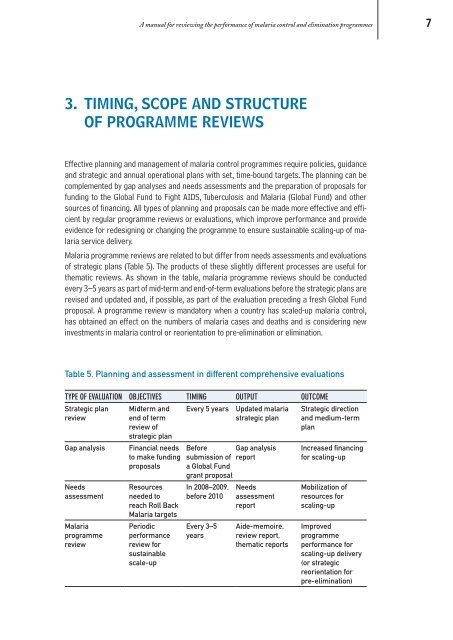Malaria programme reviews: - World Health Organization
Malaria programme reviews: - World Health Organization
Malaria programme reviews: - World Health Organization
You also want an ePaper? Increase the reach of your titles
YUMPU automatically turns print PDFs into web optimized ePapers that Google loves.
A manual for reviewing the performance of malaria control and elimination <strong>programme</strong>s 7<br />
3. tiMinG, sCoPe anD struCture<br />
oF ProGraMMe revieWs<br />
Effective planning and management of malaria control <strong>programme</strong>s require policies, guidance<br />
and strategic and annual operational plans with set, time-bound targets. The planning can be<br />
complemented by gap analyses and needs assessments and the preparation of proposals for<br />
funding to the Global Fund to Fight AIDS, Tuberculosis and <strong>Malaria</strong> (Global Fund) and other<br />
sources of financing. All types of planning and proposals can be made more effective and efficient<br />
by regular <strong>programme</strong> <strong>reviews</strong> or evaluations, which improve performance and provide<br />
evidence for redesigning or changing the <strong>programme</strong> to ensure sustainable scaling-up of malaria<br />
service delivery.<br />
<strong>Malaria</strong> <strong>programme</strong> <strong>reviews</strong> are related to but differ from needs assessments and evaluations<br />
of strategic plans (Table 5). The products of these slightly different processes are useful for<br />
thematic <strong>reviews</strong>. As shown in the table, malaria <strong>programme</strong> <strong>reviews</strong> should be conducted<br />
every 3–5 years as part of mid-term and end-of-term evaluations before the strategic plans are<br />
revised and updated and, if possible, as part of the evaluation preceding a fresh Global Fund<br />
proposal. A <strong>programme</strong> review is mandatory when a country has scaled-up malaria control,<br />
has obtained an effect on the numbers of malaria cases and deaths and is considering new<br />
investments in malaria control or reorientation to pre-elimination or elimination.<br />
Table 5. Planning and assessment in different comprehensive evaluations<br />
type OF evaLuatiOn Objectives timing Output OutcOme<br />
Strategic plan<br />
review<br />
Midterm and<br />
end of term<br />
review of<br />
strategic plan<br />
Gap analysis Financial needs<br />
to make funding<br />
proposals<br />
Needs<br />
assessment<br />
<strong>Malaria</strong><br />
<strong>programme</strong><br />
review<br />
Resources<br />
needed to<br />
reach Roll Back<br />
<strong>Malaria</strong> targets<br />
Periodic<br />
performance<br />
review for<br />
sustainable<br />
scale-up<br />
Every 5 years Updated malaria<br />
strategic plan<br />
Before Gap analysis<br />
submission of report<br />
a Global Fund<br />
grant proposal<br />
In 2008–2009,<br />
before 2010<br />
Every 3–5<br />
years<br />
Needs<br />
assessment<br />
report<br />
Aide-memoire,<br />
review report,<br />
thematic reports<br />
Strategic direction<br />
and medium-term<br />
plan<br />
Increased financing<br />
for scaling-up<br />
Mobilization of<br />
resources for<br />
scaling-up<br />
Improved<br />
<strong>programme</strong><br />
performance for<br />
scaling-up delivery<br />
(or strategic<br />
reorientation for<br />
pre-elimination)

















